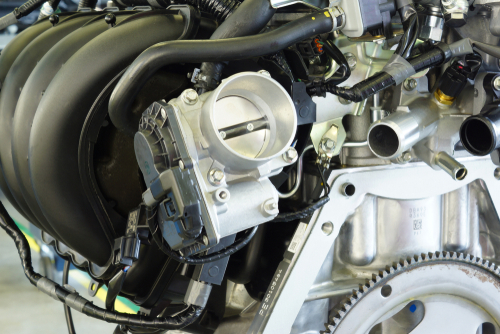Got a P0039 code popping up on your dashboard? Don’t panic just yet. This diagnostic trouble code is telling you there’s an issue with your vehicle’s turbocharger or supercharger bypass valve control circuit.
The P0039 code indicates that your engine’s computer has detected a performance problem in the system that regulates boost pressure.

You might be wondering what this means for your ride. Well, it could lead to reduced engine performance, poor fuel economy, or even potential damage if left unchecked.
But fear not, fellow gearhead! With a bit of know-how and some elbow grease, you can get to the bottom of this pesky problem.
Ready to dive under the hood and tackle this turbo trouble? Let’s break down what you need to know about P0039, from its causes to the steps you can take to diagnose and fix it.
By the end of this article, you’ll be armed with the knowledge to keep your forced induction system running smoothly.
Key Takeaways
- P0039 indicates a malfunction in the turbocharger or supercharger bypass valve control circuit
- Symptoms may include reduced engine performance, poor fuel economy, and illuminated check engine light
- Proper diagnosis involves checking wiring, sensors, and the bypass valve itself before attempting repairs
Understanding P0039
The P0039 code indicates an issue with your turbocharger or supercharger bypass valve control circuit. This pesky little problem can leave you scratching your head and your engine gasping for air.
Basics of the Trouble Code
P0039 is all about your engine’s forced induction system misbehaving. It specifically points to the bypass valve control circuit, which is crucial for regulating boost pressure.
When this code pops up, it means your car’s computer has detected that the bypass valve isn’t operating within its expected range.
Think of it as your turbo or supercharger throwing a little tantrum.
Common culprits include a faulty boost pressure sensor, a worn-out actuator, or even a rebellious bypass valve itself.
Don’t forget about those sneaky vacuum lines – they might be playing hide and seek with your boost pressure!
Differences Between a Turbocharger and Supercharger
Now, let’s chat about the dynamic duo of forced induction: turbochargers and superchargers. Both are like gym trainers for your engine, pumping it up with extra air.
Turbochargers are the patient type. They use your engine’s exhaust gases to spin a turbine, which then compresses incoming air.
It’s like recycling your engine’s breath for more power!
Superchargers, on the other hand, are the eager beavers. They’re mechanically driven by your engine’s crankshaft, providing instant boost.
No waiting around for exhaust gases here!
While both systems aim to stuff more air into your engine, they go about it in different ways. Your P0039 code doesn’t discriminate – it can show up in either system if the bypass valve starts acting up.
Symptoms and Causes of P0039

The P0039 code can be a real headache for your turbocharged or supercharged ride. Let’s dive into what you might notice and why this pesky problem pops up.
Common Symptoms
You might spot a few tell-tale signs when P0039 decides to crash your party.
First off, your trusty check engine light might start glowing like a Christmas tree. Don’t ignore it!
Your car might feel a bit sluggish, like it’s had one too many donuts. You could notice a dip in acceleration or overall engine performance.
It’s as if your turbo or supercharger has decided to take an unscheduled vacation.
In some cases, you might hear a weird whistling noise under the hood. That’s your turbo telling you it’s not happy. Your fuel economy might take a hit too, so keep an eye on those MPGs.
Root Causes
Now, what’s causing all this turbo trouble? Often, it’s the bypass valve acting up. This little gizmo controls the boost pressure, and when it’s not playing nice, your engine performance suffers.
Sometimes, it’s the electrical gremlins causing havoc. A faulty wiring connection or a short circuit in the control system can trigger this code.
Your Powertrain Control Module (PCM) might be getting confused by incorrect signals.
A failing boost pressure sensor could also be the culprit. It’s like your turbo’s brain got its wires crossed.
And don’t forget about those pesky vacuum lines – if they’re cracked or disconnected, your turbo won’t know whether it’s coming or going.
Diagnostic Steps for P0039

Diagnosing P0039 requires a systematic approach to pinpoint the issue with your turbocharger or supercharger bypass valve control circuit. Let’s walk through the steps to get your engine purring again.
Initial Inspection
Start by popping the hood and giving your engine bay a once-over. Look for any obvious signs of trouble, like damaged vacuum lines or loose connections. These little buggers can cause big headaches!
Check the air intake system for any obstructions or leaks. A clogged air filter can make your turbo work harder than a one-legged man in a kickboxing contest.
Inspect the wiring harness connected to the bypass valve. If it looks like it’s been chewed by your neighbor’s rabid chihuahua, you’ve found a likely culprit.
Don’t forget to examine the bypass valve itself. If it’s stuck or damaged, it’s about as useful as a chocolate teapot.
Using Diagnostic Equipment
Time to put on your detective hat and grab your trusty digital volt/ohmmeter. You’ll be measuring voltages faster than a Vegas card counter!
Connect your scan tool to the OBD-II port. Clear the codes and see if P0039 comes back. If it does, your ECM is trying to tell you something.
Use your volt/ohmmeter to check the resistance in the bypass valve circuit. If the readings are more off than a politician’s promises, you’ve got a wiring issue.
Consult your vehicle’s system wiring diagram. It might look like a plate of spaghetti, but it’ll help you trace the circuit and find any shorts or open connections.
Verifying the Fix
After you’ve made the necessary repairs, it’s time for the moment of truth. Clear the codes and start the engine. If the check engine light stays off, you’re on the right track.
Take your car for a test drive. Push it through different speeds and loads to ensure the turbocharger bypass valve is functioning correctly.
Keep an eye on your engine’s performance. If it’s running smoother than a buttered bobsled, you’ve likely solved the problem.
Use your scan tool to monitor real-time data. Look for any anomalies in boost pressure or bypass valve operation. If everything looks normal, pat yourself on the back – you’ve just conquered P0039!
Repair Procedures for P0039
Got a P0039 code lighting up your dash? Don’t worry, we’ve got your back. Let’s dig into the nitty-gritty of fixing this turbo trouble and get your ride purring again.
Addressing Electronic Issues
First things first, let’s tackle those pesky electronic gremlins.
Start by checking your boost pressure sensor – it’s often the culprit behind this code. Give those wires a once-over for any signs of wear or damage.
Next, take a peek at your boost pressure control module. This little gizmo can sometimes go haywire, causing all sorts of turbo-related headaches. If it’s acting up, you might need to replace it.
Don’t forget about the electronic solenoid! This component controls the bypass valve, so if it’s on the fritz, your turbo won’t know whether to boost or not. A quick test with a multimeter can tell you if it’s still kicking.
Handling Mechanical Problems
Now, let’s get our hands dirty with some mechanical fixes.
Your turbocharger bypass valve might be stuck or worn out. Give it a good visual inspection – if it’s not moving freely, it’s time for a replacement.
Vacuum leaks are another common culprit. Check all those hoses and connections around your turbo system. A tiny leak can cause big problems, so be thorough!
Lastly, don’t overlook the actuator. This little guy opens and closes the bypass valve. If it’s not working right, your turbo won’t either. Make sure it’s moving smoothly and responding to changes in boost pressure.
Remember, these repairs can be tricky. If you’re not comfortable getting elbow-deep in your engine bay, it’s best to leave it to the pros.
But with a little patience and know-how, you can often fix P0039 without breaking the bank.
Additional Considerations
When dealing with P0039, there are some extra factors to keep in mind. These can make a big difference in your diagnosis and repair process, potentially saving you time and money.
Make-Specific Issues
Saab owners, you might want to pay extra attention here. Your quirky Swedish rides often have unique turbo systems that can throw a curveball when it comes to P0039.
Check those vacuum hoses like they’re going out of style – they love to play hide and seek in Saab engines.
For you Ford fans, keep an eye out for technical service bulletins. They’ve been known to update PCM software to address false P0039 codes. It’s like getting a free upgrade for your car’s brain!
Potential for Misdiagnosis
You might think you’ve got P0039 all figured out, but not so fast! This tricky code can sometimes be a wolf in sheep’s clothing.
Spark plug fouling can mimic the symptoms, leaving you scratching your head.
Don’t forget about cylinder detonation either. It can cause similar performance issues and might fool your diagnostic tools.
Always perform a thorough inspection of related components before jumping to conclusions.
Frequently Asked Questions
P0039 codes can be tricky little buggers. Let’s tackle some common head-scratchers about these pesky turbo troubles and how to sort them out.
What’s the likely suspect when my car’s throwing a P0039 code?
Nine times out of ten, you’re looking at a defective boost pressure sensor.
These sensors can go wonky, making your car’s computer think there’s a problem with the bypass valve when it’s actually just getting bad intel.
Sometimes, it’s the turbo/supercharger bypass valve actuator itself that’s throwing in the towel.
These parts work hard and can wear out over time.
How do I troubleshoot a faulty turbocharger bypass valve control circuit?
First things first, grab your trusty multimeter.
You’ll want to check for continuity in the wiring harness connected to the bypass valve.
Look for any collapsed, disconnected, or split vacuum lines.
These sneaky little hoses can cause big problems if they’re not up to snuff.
Can a bad supercharger bypass valve lead to performance issues in my vehicle?
You bet your bottom dollar it can! A faulty bypass valve can make your engine feel as sluggish as a tortoise in a marathon.
You might notice a drop in power, especially when you’re trying to put the pedal to the metal.
It’s like trying to breathe through a straw while running – not fun!
What steps should I take if my diagnostic scanner shows a P0039 error code?
First up, don’t panic! Grab yourself a cup of coffee and let’s think this through.
Start by checking the electrical connections to your turbo or supercharger.
Loose or corroded wires can cause all sorts of mischief.
Will a P0033 code affect my car differently than a P0039, or are they pretty much causing the same headaches?
While these codes are cousins, they’re not identical twins. P0033 is more about the turbo control circuit being open or shorted.
P0039, on the other hand, is telling you there’s a range or performance issue with the bypass valve control circuit.
Both can lead to poor performance, but the root causes might differ.
Are there any common fixes for P0039 errors across different car brands, or is each one a unique snowflake?
While every car has its quirks, there are some common fixes that often do the trick.
Replacing the boost pressure sensor is a good start for many vehicles.
Checking and replacing vacuum lines is another universal fix that can solve P0039 issues across many makes and models.
It’s like chicken soup for cars – it just works!
